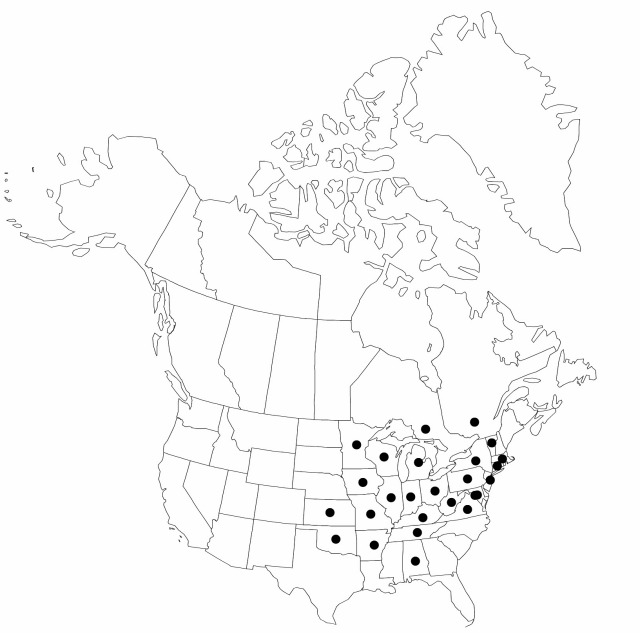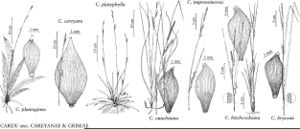Difference between revisions of "Carex hitchcockiana"
Amer. J. Sci. Arts 10: 274, plate E, fig. 17. 1826.
FNA>Volume Importer |
imported>Volume Importer |
||
| (6 intermediate revisions by 2 users not shown) | |||
| Line 8: | Line 8: | ||
}} | }} | ||
|common_names=Carex de Hitchcock | |common_names=Carex de Hitchcock | ||
| + | |special_status={{Treatment/ID/Special_status | ||
| + | |code=F | ||
| + | |label=Illustrated | ||
| + | }}{{Treatment/ID/Special_status | ||
| + | |code=E | ||
| + | |label=Endemic | ||
| + | }} | ||
|basionyms= | |basionyms= | ||
|synonyms={{Treatment/ID/Synonym | |synonyms={{Treatment/ID/Synonym | ||
|name=Carex oligocarpa var. hitchcockiana | |name=Carex oligocarpa var. hitchcockiana | ||
|authority=(Dewey) Kükenthal | |authority=(Dewey) Kükenthal | ||
| + | |rank=variety | ||
}} | }} | ||
|hierarchy=Cyperaceae;Carex;Carex sect. Griseae;Carex hitchcockiana | |hierarchy=Cyperaceae;Carex;Carex sect. Griseae;Carex hitchcockiana | ||
| Line 27: | Line 35: | ||
|elevation=60–800 m | |elevation=60–800 m | ||
|distribution=Ont.;Que.;Ala.;Ark.;Conn.;D.C.;Ill.;Ind.;Iowa;Kans.;Ky.;Md.;Mass.;Mich.;Minn.;Mo.;N.J.;N.Y.;Ohio;Okla.;Pa.;Tenn.;Vt.;Va.;W.Va.;Wis. | |distribution=Ont.;Que.;Ala.;Ark.;Conn.;D.C.;Ill.;Ind.;Iowa;Kans.;Ky.;Md.;Mass.;Mich.;Minn.;Mo.;N.J.;N.Y.;Ohio;Okla.;Pa.;Tenn.;Vt.;Va.;W.Va.;Wis. | ||
| − | |discussion=<p>Carex hitchcockiana is infrequent and local. It often grows with C. albursina, C. jamesii, and C. oligocarpa.</p> | + | |discussion=<p><i>Carex hitchcockiana</i> is infrequent and local. It often grows with <i>C. albursina</i>, <i>C. jamesii</i>, and <i>C. oligocarpa</i>.</p> |
|tables= | |tables= | ||
|references= | |references= | ||
| Line 36: | Line 44: | ||
-->{{#Taxon: | -->{{#Taxon: | ||
name=Carex hitchcockiana | name=Carex hitchcockiana | ||
| − | |||
|authority=Dewey | |authority=Dewey | ||
|rank=species | |rank=species | ||
| Line 50: | Line 57: | ||
|publication title=Amer. J. Sci. Arts | |publication title=Amer. J. Sci. Arts | ||
|publication year=1826 | |publication year=1826 | ||
| − | |special status= | + | |special status=Illustrated;Endemic |
| − | |source xml=https:// | + | |source xml=https://bitbucket.org/aafc-mbb/fna-data-curation/src/2e0870ddd59836b60bcf96646a41e87ea5a5943a/coarse_grained_fna_xml/V23/V23_830.xml |
|genus=Carex | |genus=Carex | ||
|section=Carex sect. Griseae | |section=Carex sect. Griseae | ||
Latest revision as of 21:43, 5 November 2020
Plants densely cespitose; rhizome internodes 1.8–2.5 mm thick. Culms yellow-brown to dark brown at base, 15–60 cm. Leaves: sheaths hispidulous; blades green, widest blades (3–)3.4–5.4(–6.5) mm wide, glabrous abaxially or sparsely hispidulous on midrib. Inflorescences 0.19–0.48 of culm height; peduncles of lateral spikes smooth or barely scaberulous; peduncles of terminal spikes (4.2–)7.5–37(–43) mm, much exceeding lateral spikes; proximal bract with sheath tight, abaxially scabrous, sheath front apex convex, elongated (0.6–)1.6–4.9(–6.6) mm beyond apex; ligules 3.3–5 mm; distal bract usually much exceeding terminal spike. Spikes 3–5, separate or distal 2–4 spikes overlapping; lateral spikes pistillate, with 2–7 perigynia, 6–29 × 3.8–6.8 mm, ratio of spike length (in mm) to flower number = 3.5–4.8; longest terminal spikes 14–34(–42) × 1.3–3(–3.5) mm. Pistillate scales (4.1–)5.6–9.4(–11.6) × 1.6–2.6(–3.3) mm, margins whitish, denticulate, apex with awn 1.1–6.8 mm. Staminate scales 5.2–6.9 × 1.5–1.7 mm. Anthers 3.4–4.2 mm. Perigynia distichously imbricate, 52–59-veined, unwrinkled, obovoid or narrowly obovoid, obtusely triangular in cross section, (4.5–)4.6–5.6(–6.2) × 1.9–2.2(–2.3) mm, (2.1–)2.3–2.8(–3) times as long as wide, dull, base gradually tapered, apex abruptly contracted; beak excurved, (0.5–)0.8–1.3 mm. Achenes obovoid-ellipsoid, 3.2–3.9(–4.2) × (1.6–)1.8–2.1 mm, tightly enveloped by perigynia; stipe bent 45–70°, 0.4–0.6 mm; beak bent more than 90°, 0.3–0.5 mm.
Phenology: Fruiting spring–summer.
Habitat: Mesic, usually rocky, deciduous forests, usually with highly diverse vascular plant communities, often in calcium-rich loams on slopes above streams
Elevation: 60–800 m
Distribution

Ont., Que., Ala., Ark., Conn., D.C., Ill., Ind., Iowa, Kans., Ky., Md., Mass., Mich., Minn., Mo., N.J., N.Y., Ohio, Okla., Pa., Tenn., Vt., Va., W.Va., Wis.
Discussion
Carex hitchcockiana is infrequent and local. It often grows with C. albursina, C. jamesii, and C. oligocarpa.
Selected References
None.
